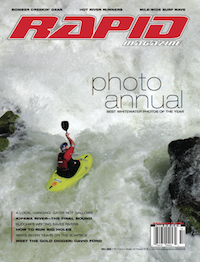On large-volume rivers the predictable constants of rock and earth are submerged and replaced with the increasingly chaotic forces of moving water.
Properly assessing one’s mental preparedness and physical fitness, the rapid’s geographic remoteness, and the ability to set up adequate safety are the first steps in deciding to attempt any run. When the run involves extremely large holes, however, there are specific technical variables to consider, including the behavior of the water, your equipment, and your paddling technique.
Being able to see where the current pushes down- stream through a large-volume hole is the greatest challenge when scouting a feature because this flow will often be covered by a large reversal. You can usually tell where the passing current exits the foampile by identifying where the water boils up most significantly on the downstream side of the feature. By connecting the current’s entrance to the exit, you’ll identify a potential passage beneath the whitewater.
Any path through the feature will almost certainly be deep if you are scouting a truly big hole. Properly aligning your boat with this downstream flow will allow you safe passage by sending you beneath the oncoming speed and power of the recirculating whitewater, not through it or over it.
Your boat is the second variable and the choice you make depends on your ability to read the water. Assessing how deep you will need to go for safe passage through the hole dictates the size and shape of the best boat. The physical properties must provide not just the appropriate buoyancy, but also the tracking ability needed for you to stay online and establish the necessary momentum. Smaller boats are less buoyant and better for subbing out in the deep flow, but lack speed and momentum. Big boats, on the other hand, provide plenty of momentum for punch- ing medium-sized holes, but because of their buoyancy can prevent you from flushing through a hole with the passing current.
The final tactic to employ is proper paddling technique. Aggressive vertical forward strokes and sweeps at the bow will position your boat properly in the current with the correct momentum for entry. A good “tuck and duck,” in which you kiss the skirt and line the paddle up parallel with the prevailing current, will prevent de-limbing. Initiate your exit strokes as a continuation of your tucked paddle position, which will usually be a low brace using the blade behind your hip or a forward stroke using the blade in front of your nose. Placed properly, these strokes will help propel you past the boil point of the hole along with the current continuing downstream.
Above all, remain rational and confident when choosing to lose yourself in a big water giant. The human desire for increasingly larger challenges should be tempered with humility, and knowledge gained from experience. Keep your head by being in the right place with the right people for the right reasons at the right time.
Scott Doherty, who has a master’s degree in education and is an ACA kayak instructor, did the research for this piece on the Stikine and White Nile rivers.




